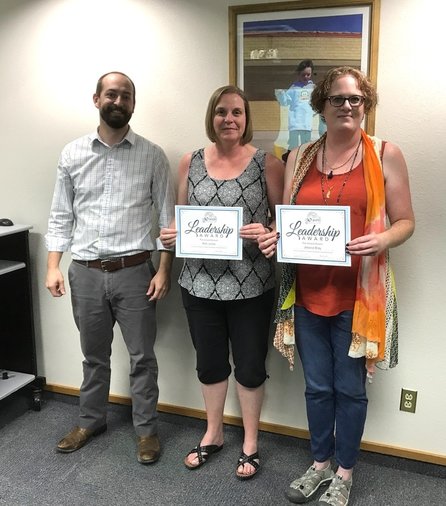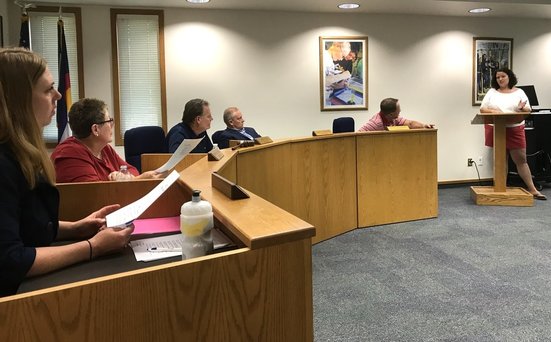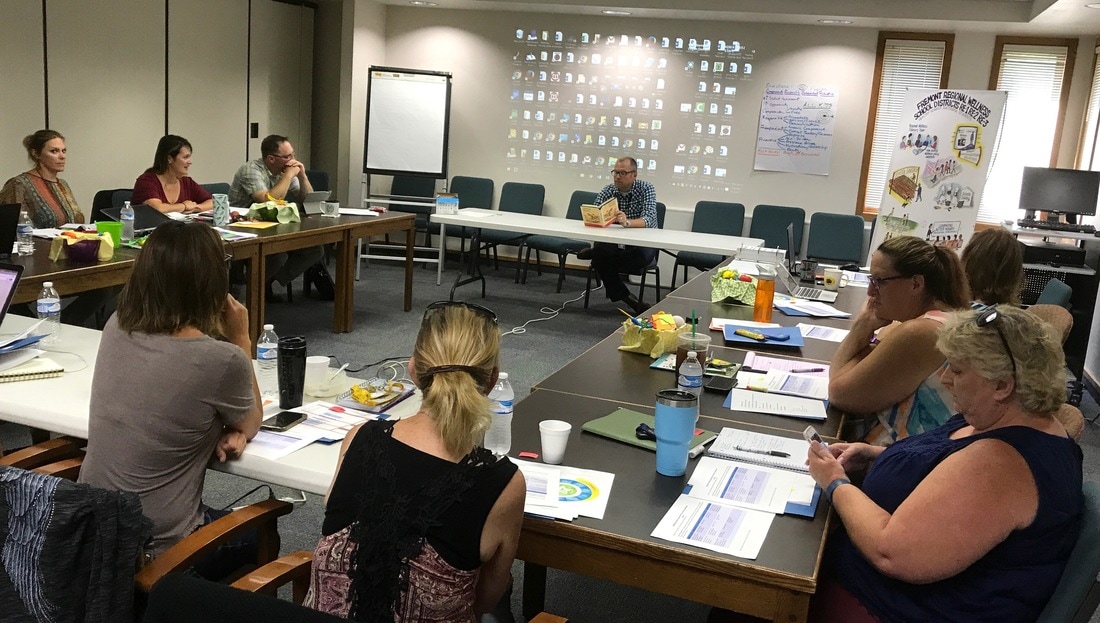Echoes from Cañon
Examples of Excellence
 While presenting student achievement data to our board of education, Chris Mayberry from Lindamood-Bell acknowledged great work performed during the past year by literacy coaches Kelli Jones and Jessica Bray.
While presenting student achievement data to our board of education, Chris Mayberry from Lindamood-Bell acknowledged great work performed during the past year by literacy coaches Kelli Jones and Jessica Bray.
An item I failed to report on earlier this year was a teen automobile safety incentive initiative that took place at Cañon City High School during the week of December 19 through 21, 2016. At that time Cañon City Police Officers and Cañon City High school National Honor Society and Student Council members observed students leaving the school parking lot each day during lunch hour looking for safety belt and texting while driving violations. Funds from the Royal Gorge Youth Initiative were used to purchase school ID badge lanyards with “CCHS Tigers Don’t Text & Drive - Wear Your Safety Belt” written on them as incentives. 284 lanyards were given to students exhibiting good driving or passenger behavior in 94 different vehicles, with only actual 2 violations being reported (and police officers issued written warnings to those students). In addition to lanyards, Burger King, Sonic, and Wendy's gift cards were awarded as reinforcement. A CCPD communication stated, “our police force is committed to educating young drivers about safety and we truly appreciate our partnership with National Honor Society and Student Council members Alyssa Soto, Camie Hall, Emily Reynolds, Ellie Enderle, Mike White, Michael Katchmar, Skylar Edwards and Kenan White during this initiative.” What a wonderful safety message to send to our kids!
At our June 12th board of education meeting Jamie Davis, our new teacher induction coach, shared data showing the value her program offered to last year’s crop of new teachers, including how 11 of 12 participants committed to returning to work in the Cañon city School District next year. Jamie was also excited to report how she’ll be able to expand the time she spends preparing our new teaching staff to work with our students before the 2017-18 school year starts, thanks to a minor change in our annual work calendar.
Also at our June 12th board of education meeting Lindamood-Bell regional manager Chris Mayberry reported progress made by students in grades K-3 who participated in Seeing Stars reading intervention groups this year. Highlights from his report included how the 27 Cañon Exploratory School students increased from average 18th percentile comprehension to average 32nd percentile comprehension. 32 Harrison K-8 participants grew from the 13th to the 37th percentile in comprehension. Meanwhile, Lincoln’s 24 participants advanced from the 16th to the 50th percentile, McKinley’s 11 participants advanced from the 27th to the 50th percentile, and Washington’s 25 students grew from the 9th to the 21st percentile, on average. In all the 119 students receiving more than 100 hours of Lindamood-Bell Seeing Stars reading interventions advanced from 14th percentile average reading comprehension (well below normal performance) to the 34th percentile (well into the normal range). This is even more exciting to hear considering in past years similar students have often fallen farther behind grade level performance, as opposed to catching up. This is truly exciting news!
At our June 12th board of education meeting Jamie Davis, our new teacher induction coach, shared data showing the value her program offered to last year’s crop of new teachers, including how 11 of 12 participants committed to returning to work in the Cañon city School District next year. Jamie was also excited to report how she’ll be able to expand the time she spends preparing our new teaching staff to work with our students before the 2017-18 school year starts, thanks to a minor change in our annual work calendar.
Also at our June 12th board of education meeting Lindamood-Bell regional manager Chris Mayberry reported progress made by students in grades K-3 who participated in Seeing Stars reading intervention groups this year. Highlights from his report included how the 27 Cañon Exploratory School students increased from average 18th percentile comprehension to average 32nd percentile comprehension. 32 Harrison K-8 participants grew from the 13th to the 37th percentile in comprehension. Meanwhile, Lincoln’s 24 participants advanced from the 16th to the 50th percentile, McKinley’s 11 participants advanced from the 27th to the 50th percentile, and Washington’s 25 students grew from the 9th to the 21st percentile, on average. In all the 119 students receiving more than 100 hours of Lindamood-Bell Seeing Stars reading interventions advanced from 14th percentile average reading comprehension (well below normal performance) to the 34th percentile (well into the normal range). This is even more exciting to hear considering in past years similar students have often fallen farther behind grade level performance, as opposed to catching up. This is truly exciting news!
The Focus of Our Work
 Teacher induction coach Jamie Davis presents the results of her first year efforts to the board of education.
Teacher induction coach Jamie Davis presents the results of her first year efforts to the board of education.
On Monday June 12th we held a Summer Grant Summit thanks to the coordination efforts of director of instruction Adam Hartman and director of student support services Paula Buser. At this meeting regional health and wellness coordinator Kristi Elliott shared information about health and wellness grant work she is guiding, district nurse Patricia Sallie shared information about several health professional grants we are implementing, CCHS counselor Stacy Andrews shared information about our Counselor Corps grant, and CCHS counselor Christie Graham explained the goals of our Expelled and At-Risk Student Support Services grant. Most of our principals were in attendance, and our primary goal was ensuring everyone understands how each of these initiatives are designed to support our district student outcomes goals.
As we are in the process of finalizing our annual budget I thought it might also be a great time to highlight our district academic improvement goals as outlined in our Unified Improvement Plan. During the 2017-18 school year we intend to focus our work in the following areas:
We'll continue improving literacy classroom instruction and our capacity to deliver literacy interventions to advance the rate at which students throughout our school district read at or above grade level, while also taking action to improve the reading ability of children we identify performing significantly below grade level expectation. We'll pay for this work with our three-year, $900,000, Early Literacy Grant and some funds set aside from our one-time injection of Rural Sustainability Act funding.
We'll also work to implement common writing instruction language, and common standards driven, unit based, writing assessments across all grade levels. This work should cost no extra money, though some delayed start professional development time will need to be allocated toward the effort.
We'll complete the development of our K-12 math curriculum by aligning it to current state standards, purchasing updated resources to teach it, teaching it with fidelity, and periodically measuring student learning of it. We'll pay for this work with a portion of our one-time Rural Sustainability Act funds.
Finally, we'll work to ensure all teachers grow in their use of instructional strategies that fully engage all students in classroom learning each day. This work will first focus on building the skills of our instructional leaders, and their expanded expertise will be used to support and coach teachers to use such strategies.
These instructional improvement goals were developed based on input from our district leadership team, instructional leader PLC, and district accountability committee. If we make progress on these goals similar to that which we made this year on our Early Literacy Grant and high school pathways initiative, our students will soon reap the benefits of our efforts.
As we are in the process of finalizing our annual budget I thought it might also be a great time to highlight our district academic improvement goals as outlined in our Unified Improvement Plan. During the 2017-18 school year we intend to focus our work in the following areas:
We'll continue improving literacy classroom instruction and our capacity to deliver literacy interventions to advance the rate at which students throughout our school district read at or above grade level, while also taking action to improve the reading ability of children we identify performing significantly below grade level expectation. We'll pay for this work with our three-year, $900,000, Early Literacy Grant and some funds set aside from our one-time injection of Rural Sustainability Act funding.
We'll also work to implement common writing instruction language, and common standards driven, unit based, writing assessments across all grade levels. This work should cost no extra money, though some delayed start professional development time will need to be allocated toward the effort.
We'll complete the development of our K-12 math curriculum by aligning it to current state standards, purchasing updated resources to teach it, teaching it with fidelity, and periodically measuring student learning of it. We'll pay for this work with a portion of our one-time Rural Sustainability Act funds.
Finally, we'll work to ensure all teachers grow in their use of instructional strategies that fully engage all students in classroom learning each day. This work will first focus on building the skills of our instructional leaders, and their expanded expertise will be used to support and coach teachers to use such strategies.
These instructional improvement goals were developed based on input from our district leadership team, instructional leader PLC, and district accountability committee. If we make progress on these goals similar to that which we made this year on our Early Literacy Grant and high school pathways initiative, our students will soon reap the benefits of our efforts.
Last Week
 Adam Hartman, director of instruction, guides work that took place at our summer grant summit.
Adam Hartman, director of instruction, guides work that took place at our summer grant summit.
Last week I attended the grant information summit director of instruction Adam Hartman and director of student support services Paula Buser arranged to ensure building leaders understand how our grant initiatives work together in support of our student outcome goals. I also met with Chris Mayberry from Lindamood-Bell to learn results of our year-one reading intervention implementation, attended a board work session and regular meeting, attended a Building Bridges for Quality Cañon City Schools gathering, participated in a Communities That Care training session, and held a monthly touching base meeting with Fremont County Department of Human Services director Steve Clifton. A highlight of my week was also meeting our new Chief of Police Daric Harvey at our monthly meeting with the Cañon City Police Department. Welcome to Cañon Chief Harvey!
This Week
This week I will spend a lot of time completing our annual federal programs grant application. I will also wrap up several more employee evaluations, attend the usual Superintendent Advisory Council meeting, attend a meeting with folks at Southern Peaks Learning Center, conduct a touching base meeting with director of special services Lynnette Steinhoff, attend a meeting about possibly applying for a P-Tech grant with our partners at Pueblo Community College, participate in an Early Childhood Leadership Commission meeting in Denver, and attend a quarterly Fremont Facilities Corporation meeting.
Thanks for listening once again.
George S. Welsh
Thanks for listening once again.
George S. Welsh
